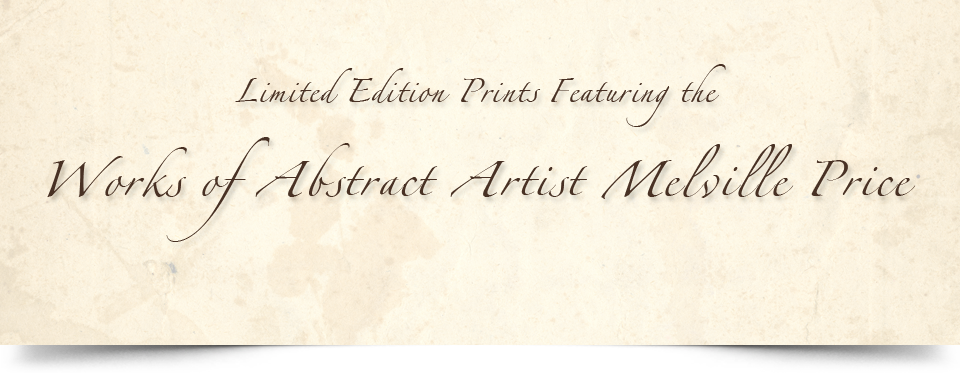|
Melville Price (1930 – 1970)
School of Abstract Expressionism
First Generation
Alliant Gallery invites you to an exhibition of Melville Price’s “Black Warrior” prints.
Melville Price (1930 – 1970)
Melville Price came of age as a painter in the 1940’s. He was one of the youngest members of the first generation of Abstract Expressionists and exhibited with the leaders of that movement: Ashile Gorky, Willem de Kooning, and Jackson Pollock. It is said that “Melville Price cut his artistic teeth in a time and place almost mythic in the history of American Art.” Price was 20 when he first came into contact with these artists.
In 1936 as war began to threaten Europe, American and European painters banded together in an association known as the American Abstract Artists and came into their own in the early 1940’s.
Price was part of this informal revolutionary group of “action painters.” In the mid-40s Price began showing in group exhibitions with de Kooning, Gotlieb, Kline, Pollock, Tomlin, Bourgeois, Hoffman and Stamos.
Known for spontaneous and dramatic brush work on monumental canvasses, the Abstract
Expressionists worked with large powerful gestural strokes that slashed, dripped, and smeared across the entire field of the canvass.
Price came from an affluent family whose wealth decline during the Great Depression. President Roosevelt in an effort to provide economic relief to America, established the Works Progress Administration (WPA). Price went to work for the WPA Fine Arts Program in the painting division and made the acquaintance of Ashile Gorky, de Kooning, Pollock and Kline. Franz Kline became Price’s closet friend throughout his life. Some of the other 20th century's greatest visual artists were employed by WPA Fine Arts Program: Lee Krasner, Mark Rothko, Philip Guston, Thomas Hart Benton and Stuart Davis.
Financially limited, Price rented a small cold water studio in Manhattan while studying at the Arts Student League, the Academy of Art and Design, and the New School. As an informal member of the Abstract action painters he socialized with them. They visited each other’s studios, gathered regularly at the end of the day in The Cedar Tavern in Greenwich Village, and participated in The Club, the intellectual center of the “New York School” of Abstract Expressionist led by Kline and de Kooning.
In 1949 and 1950 Price had two one man shows at the Peridot Gallery and his work was reviewed by the New York Tribune and noted for his “vigorous style” and “outstanding characteristic of energy” that never gave the eye a moment of rest. Price was a master at highly charged gestural strokes of raw energy – intense, powerful and edgy.
His “Black Warrior” series is named after a great Indian chief Tuskaloosa (in Muskogean “tuska” means Warrior and “lusa” means Black) and the Black Warrior River. These canvasses were painted with a broad brush of black and white that dominated the canvass with their energy. His studies for this series are interwoven with limited fresh colors.
|
Public Collections
Art Institute of Chicago
Baltimore Museum of Art
Birmingham Museum of Art
Clay Center for the Arts and Sciences of West Virginia
Corcoran Gallery of Art, Washington, D.C.
Fayette Museum
Greenville County Museum of Art
Los Angeles County Museum of Art
Milwaukee Art Museum
Pennsylvania Academy of Fine Art
Philadelphia Museum of Art Rockford Art Museum, Illinois
Smithsonian America Art Museum, Washington, DC
Speed Art Museum
University of Chicago
Price’s work is found in many notable private collections.
|
“Melville Price was a most important person in my
life, both as a mentor and as a friend. He always
challenged me, throughout the length of our
friendship. In fact, he made a point of never
making anything easy. It took sometimes for me to
understand how valuable this was. It’s the aspect of
our relationship for which I am most grateful. It
was also Mell who convinced me to leave Alabama.
He urged me to go to New York, to break out of
the comfort and familiarity of life in Tuscaloosa.
This seemed at times a contrary position for him to
take. Because he would often talk about how
difficult he himself had found living in New York
to be. I think this was the teacher in him – he
knew that it was necessary for me to distance myself
from my surroundings, and to experience the larger
world outside of the South. He was, as usual,
right.”
William Christenberry
Photographer
Pace/MacGill Gallery, New York City
|
|

